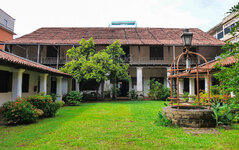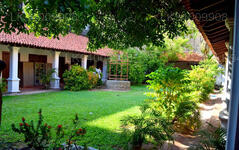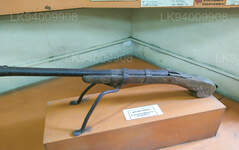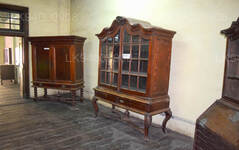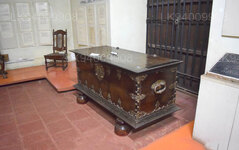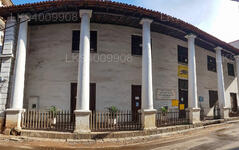
科伦坡市
科伦坡是斯里兰卡的首都,是一座充满活力的城市,融合了传统与现代。它拥有殖民时期的建筑、热闹的市场和宁静的佛教寺庙。科伦坡拥有多元化的美食、不断延伸的天际线和美丽的海滩,是充满活力的商业、文化和旅游中心,也是探索斯里兰卡奇观的门户。
Dutch Period Museum
The Construction
In the late 1600s the Dutch era had just started in Sri Lanka. The Dutch were proceeding to destroy all traces of Portuguese occupancy so that their presence would be indelibly established amongst the masses.
They also built many structures to suit their purposes; and Colombo, which had been a port of great importance to the Portuguese, became one of their target locations. The Dutch built hospitals, churches, residences, military barracks, and much more. Amongst these resplendent structures was a colonnaded two-story building, the best of the Dutch architecture from the era.
The building was built in 1692 to be the residence of the Governor of Dutch Ceylon, Thomas van Rhee. Governor van Rhee’s term of office came to an end in 1697, and the structure lost its use as a residence for the Governor. The Dutch had no interest in letting such a big and luxurious (at the time) structure go to seed. They used it for a variety of purposes over the years.
Repurposing
For the next several decades, the 17th century Dutch urban-style residence functioned as a seminary. It became an institution the Dutch used for educating the clergymen who later served in the churches that were being built by them. Towards the latter part of the 18th century, it also served as the residence of Colonel August Carl Frederick Von Ranzow. Afterward, it became an orphanage under the supervision of deacons from the Dutch church and was financed by the Dutch East India Company.
In the late 1700s, the British invaded, and in 1796 the rule of the much-contested island of Sri Lanka was taken over by the British. Another round of building and restructuring followed their arrival, as once again the British tried to erase as many traces of their predecessors, or at least make what was leftover part of their own culture.
The structure of the Dutch Museum, which until then had been an orphanage, got converted into a military hospital to handle the wounded from the battles that the British were waging in the vicinity of Colombo. It served as a hospital for almost half a century, until it became converted into military barracks in the latter half of the 19th century.
At the turn of the century, in the year 1900, the British decided to convert the place into a police training school. It served in such a manner until the year 1932 when the old Dutch building became the Pettah Post Office in the now flourishing city of Colombo.
The Fall of a Monument
Though the building was large and spacious, and quite comfortable for the purpose, it wasn’t to be for long. In 1971, the age-weakened outer walls collapsed during the heavy monsoonal rains of Sri Lanka. The entire structure was deemed dangerous and immediately abandoned.
Restoration and opening of the Museum
With the location being a valuable piece of real estate, as it was right in the middle of the business center of Colombo at the time, the ruined structure was slated for demolition by the government. However, intense protests by the Royal Asiatic Society and the Dutch Burgher Union prevented such plans.
In 1973, a decision was made to restore the building and convert it into a museum for Dutch colonial-era artifacts. As such a committee was established with representatives from the Ceylon Tourist Board, the Department of Archaeology, the Netherlands Alumni Association of Lanka, and the National Archives.
Meetings were held and plans made, In 1977, restoration was started on the old Dutch building with the sponsorship of the Netherlands government. The structure was rebuilt to the exact specifications of the former building and was completed in 1981. It portrayed the unique architectural features of a colonial Dutch townhouse.
The structure opened its doors as a museum to the public in 1982. Over 3000 Dutch era artifacts were stored and displayed there. Amongst the displays were furniture, ceramics, coins, and weaponry that showed off the many facets of contemporary life and culture in the Dutch Colonial Era of Sri Lanka.
In 1999, the value of the Museum as a historical monument was recognized by the Sri Lankan government. On the 18th of June 1999, they formally declared it an archaeologically protected monument of Sri Lanka under Gazette Number 1085.
To this day, the artifacts in the Dutch Museum and the history that pervades its halls make it a huge draw for locals and tourists alike.
关于科伦坡区
科伦坡是斯里兰卡最大的城市和商业中心,位于岛屿西海岸,毗邻斯里兰卡首都斯里贾亚瓦德纳普拉科特。科伦坡是一座繁忙而充满活力的城市,融合了现代生活、殖民时期的建筑和遗址,城市人口为647,100人。科伦坡都会区由科伦坡、加姆珀哈和卡卢特勒三个区组成,人口估计为5,648,000人,占地面积3,694.20平方公里。科伦坡是一座多民族、多文化的城市,也是斯里兰卡人口最多的城市,市区内居住着642,163人。科伦坡的人口由多个民族组成,主要包括僧伽罗人、摩尔人和泰米尔人。城内还居住着一些小型社区,包括华人、葡萄牙人、荷兰人、马来人和印度人,以及众多欧洲侨民。绝大多数斯里兰卡企业的总部都设在科伦坡。这些企业涉及的行业包括化工、纺织、玻璃、水泥、皮革制品、家具和珠宝。市中心坐落着南亚第二高的建筑——世界贸易中心。
关于西部省
西部省是斯里兰卡人口最稠密的省份。立法首都斯里贾亚瓦德纳普拉科特和国家行政及商业中心科伦坡均位于此。西部省分为三个主要区:科伦坡区(642平方公里)、加姆珀哈区(1,386.6平方公里)和卡卢特勒区(1,606平方公里)。作为斯里兰卡的经济中心,所有大型本土和国际企业都在此设立办事处,所有主要的设计师品牌和商业街零售商也都在此设立,所以准备好在西部省尽情享受购物的乐趣吧。西部省是斯里兰卡人口最多的省份,岛上几乎所有顶尖的教育机构都位于这里。该省的大学包括科伦坡大学、斯里贾亚瓦德纳普拉大学、凯拉尼亚大学、斯里兰卡开放大学、斯里兰卡佛教与巴利语大学、约翰·科特拉瓦拉将军国防大学和莫拉图沃大学。西部省拥有全国最多的学校,包括国立学校、省立学校、私立学校和国际学校。

